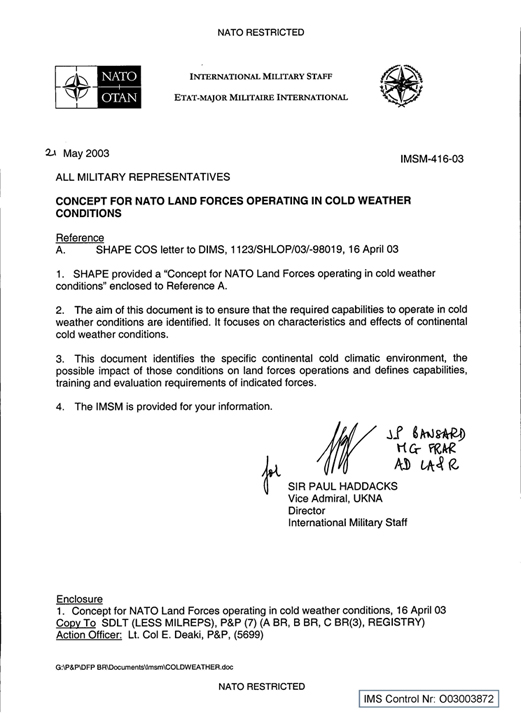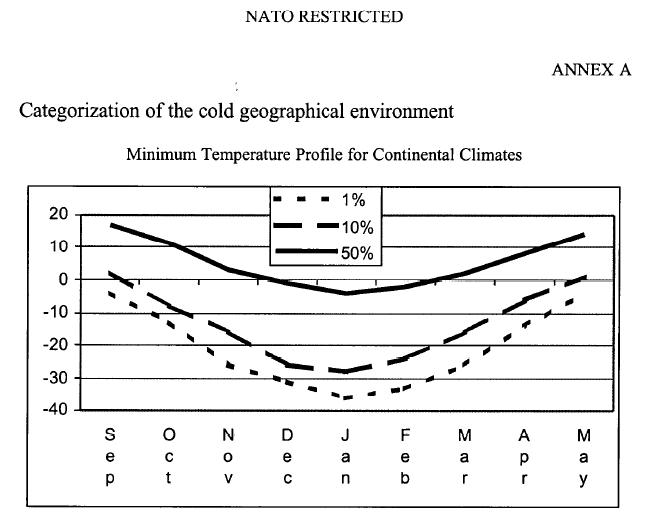Supreme Headquarters Allied Powers Europe
- 24 pages
- NATO Restricted
- April 2003
General
1. The background for this concept is the decision to cancel the NATO Composite Force (NCF) and its associated concept.
2. Individuals and units must always take precautions against the special conditions caused by weather. This is especially true for winter conditions with low temperatures, snow, wind, darkness, humidity, mist and rain. Units need to survive and be capable to conduct operations in such environment. This can only be achieved by gaining experiences through training and exercising under such conditions.
3. Ref K constitutes, that “deployable high readiness forces, as a whole, must be capable of deploying within or beyond Alliance territory. A large portion of the areas within and beyond Alliance territory where a significant portion of NATO forces could be expected to operate, experiences either continental cold or extreme hot desert weather. For some operations, this requirement demands specialised clothing, equipment, training, preventive medical measures, infrastructure and geographic support”. This documents is focussed on continental cold weather conditions.
4. Although all military personnel and units need to be trained to operate and sustain in cold weather conditions, only a limited number of units would be required for operations under extreme cold weather.
5. This document is focussed on land forces.
Aim
6. The aim of this concept is to ensure that the required capabilities to operate in cold weather conditions are identified. In support of that aim, the lessons learned from the execution of the NCF Concept were captured.
7. Identified operational requirements for forces are to be translated into measurable force standards in order to facilitate training and evaluation and thus ensuring that these capabilities are maintained in the NATO Force Structure.
8. This document may also assist Force Planners to validate the requirements derived from FP 0048 and measure those against capabilities identified by this concept. Any capability gap will have to be translated into a specific requirement for
a specific number of units.9. The aim of this document is not to provide prescriptive guidance nor will it go into the required detail for highly specialised forces operating in extreme cold weather conditions.
Scope
10. This document:
– Identities the specific continental cold climatic environment.
– Identifies the possible impact of those conditions on land forces operations.
– Defines required capabilities of indicated forces.
– Can be translated into measurable Force Standards and thus identify training and evaluation requirements.
…
…
Special equipment and clothing
ANNEX B
The following special equipment will be vital for successful winter operations by providing mobility and survivability during winter conditions:
– Skis and/or snowshoes are essential to the mobility of non-armoured or nonmechanised manoeuvre units.
– Ski or snowshoe mobile light infantry and reconnaissanceu nits will require sleighs to improve their mobility and increase their capacity to deploy support weapons, ammunition and other vital equipment off the axis and away from the line of march.
– All non-artnoured units, which are required by their operational task or support/logistic function to manoeuvre away from snow, cleared roads and echelon areas, should be equipped with or reinforced by over snow vehicles. Other vehicles will need to be adat ptedt o the specific conditions.
– The mobility of tanks and armoured personnel carriers (APCs), arrnoured infantry fighting vehicles (AIFVs) and arrnoured combat vehicles (ACVs) will be hampered during extreme deep snow operations. Tracked vehicles will, by being equipped with specially designed snow grips, improve their deep snow capability. Wheeled APCs, AIFVs and ACVs have to be equipped with snow-chains.
– Snow removal capacity must be available. Bulldozers and wheel loaders equipped with snow removal devices like snow blowers, snowploughs and special designed snow buckets, are needed. Engineer equipment such as graders, normally equipped bulldozers, tractors and wheel loaders will have a limited snow removal capability. Non-tracked equipment must have snow or ice chains available.
– The individual soldier must be issued with uniform clothing appropriate for winter conditions. Normal field clothing for temperate conditions may be suitable, provided additional items are available including:


